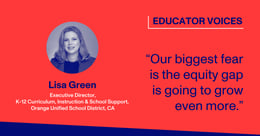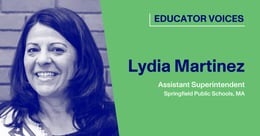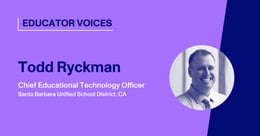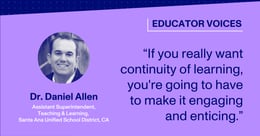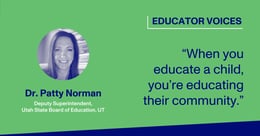
Broadening Your Equity Lens: 5 Practices Beyond 1:1 Devices
We already learned that technology and educational equity have become inextricably tied since the pandemic. But for true educational equity, we have to go beyond the ubiquity of devices and hotspots—to examine the what, who, and how of teaching and learning.
→ Read the case study on Val Verde
As part of a new series, on April 29, Paper and CITE co-hosted a panel of district leaders to share how they’re scaling their initiatives and practices to serve more students, better.
Watch the full discussion with Glenn Alegre, Executive Director of Technology, Innovation & Assessment at Moreno Valley USD; Ben Markley, Chief Technology Officer at Hemet USD; Michael R. McCormick, Superintendent at Val Verde USD; and Dr. Ryan Smith, Assistant Superintendent, Educational Services, Paramount USD here.
→ Watch the webinar recording now
Below are 5 ways for district leaders to broaden their equity lens:
1. Broadband as a utility and solving the 'last mile' connectivity problem
2. Culturally affirming, safe spaces and radical empathy in the classroom
3. More democracy in the classroom and improving student engagement
4. Community partnerships and giving every stakeholder a voice
5. Future-readiness as the North Star and avoiding deficit labels
1. Broadband as a utility and solving the 'last mile' connectivity problem
With device and internet access now seen as public utilities, districts nationwide have arguably made the most progress in this particular area of equity.
Glenn Alegre and his team realized early on into the pandemic that tech deployments couldn't end with 1:1 hotspots. Recognizing that they're serving many households with five to seven children, Moreno Valley USD deployed multiple hotspots per family to ensure adequate connectivity and processes for replacement and repair. They also worked with their transportation department to deploy Wi-Fi buses that would be parked in community spaces such as Target parking lots.
Fellow district technology leader Ben Markley outlined how IT teams' functions have evolved over the past year to tackle ongoing equity challenges in the community. Seeing hotspots as more of a short-term and less comprehensive solution, the Hemet USD team is currently solving the 'last mile connectivity' problem by challenging the USAC system through e-rate to allow them to extend their connectivity networks beyond the district premises into the broader community.
→ Learn about the 5 Steps for Effective TCO Management At Your District
2. Culturally affirming, safe spaces and radical empathy in the classroom
Conversations about educational reform have been around for the past 50 years. The pandemic simply helped spotlight some long-standing inequities—not just around technology access but also around teaching and learning practices.
Mike McCormick explained how districts must create culturally affirming spaces that are psychologically safe for all students. To create empathetic classroom spaces that value all learners, teachers, administrators, school leaders, support staff must understand themselves and their roles and embody "outrageous love and radical humility." When we have empathy, we can look at what each unique individual student has to bring to the table. If we expand our definition of the teacher-student relationship beyond just a 180-day commitment to a nearly 20-year one, we can create authentic and equitable relationships and engagement across learning settings.
For Dr. Ryan Smith, the work with equity that lies ahead is about identifying experiences and type of instruction each of their students deserves and building a plan to ensure they get it. One of the non-negotiables he identified is bringing the highest quality of passionate teachers to provide rigorous, personalized, and culturally relevant pedagogy to drive engagement and accelerate learning.
Ben added that part of this empathy and equity conversation involves incorporating the perspectives and experiences of families and students into decisions, even in grading policies and practices. The purpose of assessments isn't to punish students or burden them with more stress but to reward them for their efforts or recognizing where they need more resources or attention from their instructor. The fixation on learning loss in education needs to be replaced with an empathy-first approach. According to Ben, we have the opportunity to address those deficiencies in the system moving forward.
→ Learn more about tech infrastructure
3. More democracy in the classroom and improving student engagement
Glenn described how the classroom is no longer the classroom, but the kitchen table, the living room floor, or the bedroom. Thus, teachers have been provided unprecedented context into each other's home environment.
Ben explained that this is a great opportunity that districts shouldn't take lightly—to understand what students are dealing with every single day. He provided an example from the early pandemic days that he's sure most other district administrators have faced a variation of. A student contacted his team to see if they could pick up a device on a pick-up time outside the hours set up by the district. Confused at first as to why they wouldn't adhere to the timings provided, Ben was told by the student that they were taking care of younger siblings while their older brother and aunt were at work during the day, and so they couldn't get there in time. This shift in perspective helped the team at Hemet USD reevaluate how they operate and what they expect from families, and Ben hopes this is happening throughout the K-12 system.
A recent development in education is how expectations in the classroom between students and teachers are increasingly bidirectional. Not long ago, students would walk into the four walls of their classroom and pretty much be "held hostage" for a number of hours, with teachers able to control their actions and attention within that space. Now, students can say, "I'm not going to connect," "I don't like your class," or "I'm going to engage with something else." Teachers have really had to rethink how they can create opportunities for all students to want to be in school, be engaged, and feel valued.
4. Community partnerships and giving every stakeholder a voice
Glenn pointed out that many incredible things are happening this year because the boundaries of school walls are disappearing with online communication. He gave the example of how attendance in committees like the African American Parents Advisory Committee (AAPAC) and District English Learner Advisory Committee (DLAC) are soaring due to more people being able to jump on Zoom links instead of driving over to the district. This allows more parents and family members to give input as to what's going on in the classroom, at home, or in the district at large. Moreno Valley USD is committed to fostering school-family partnerships in these ways, recognizing that this is what allows everybody to succeed.
Ryan identified the other piece to this work, which is determining where partnerships can be formed. Paramount USD has always had a strong relationship with the City of Paramount. When they were thinking about meeting the need to provide 24/7 on-demand support for students, it led them to partner with Paper and other after-school programs with the City's help with funding. That's a beautiful thing, explained Ryan, because we're all working towards a common goal, which is what's best for our students.
5. Future-readiness as the North Star and avoiding deficit labels
Mike outlined the other immediate and significant need for K-12 education—to make sure that we're re-engaging students as they move back into face-to-face instruction for summer and fall. He warned about the need to be very careful about using deficit labels with this generation of students. Though not naive enough to think that students didn't get as much opportunity to what they needed to learn over the past year, he stated that this is probably the first generation of students that have actually become proficient in the tools and skills, and dispositions that are needed to be successful in post-secondary education and various career spaces. They now have a leg up more so than any previous generation of students because of this. Val Verde is committed to making sure all students continue to embody their "portrait of a graduate" as students return in person, complementing it with extensive teacher training around socio-emotional learning and community building.
Ryan reiterated how there has been plenty of learning taking place during this entire period of the pandemic, but that it just isn't what we've typically measured or valued in assessments and accountability. Moving forward, districts must ensure instruction is highly personalized for every student to accelerate learning. They need to continue to improve whole-child and wraparound supports. They need to work towards increasing community and connectedness. Class material needs to be engaging and relevant to students—it makes a huge difference when students care about what they're learning.
He added that if they're hyperfocused on learning loss, districts won't accomplish very much—we have much more work to do than just close achievement gaps.
→ Learn how to navigate federal funding in 2021
More like this
This panel discussion concludes our series in collaboration with CITE on scaling 1:1 experiences for every student. Across three diverse panels, district administrators unpacked the cost, infrastructure, and equity implications of 1:1.
Read previous recaps here:
• Anytime, Anywhere: 5 Steps for Innovating District Tech Infrastructure
• Start With Why: 5 Steps for Effective TCO Management At Your District

